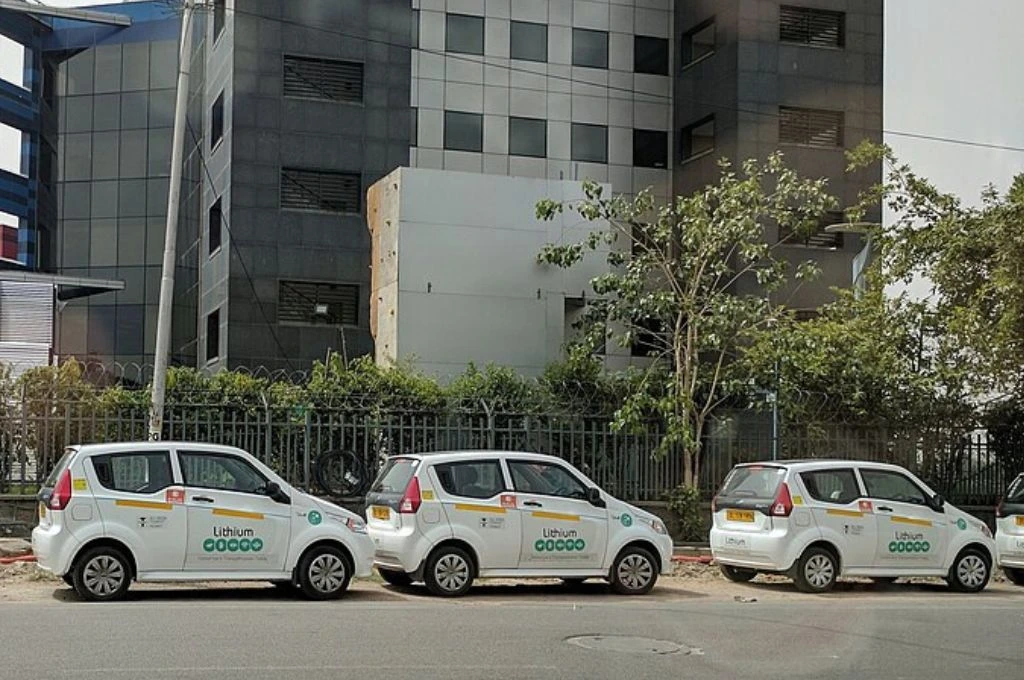India’s transition to a net-zero society is contingent on not only innovation and improvements in low-carbon technologies but also people’s willingness to adopt them. While often overlooked, both individual and collective action are critical for reducing greenhouse gas emissions in key sectors such as energy generation, electricity consumption, and mobility.
In India, mobility-related emissions have increased by 224 percent between 2000 and 2019 and contribute to one-fifth of Indian households’ carbon footprints. Rapid urbanisation and rising incomes are driving more and more households to acquire private, motorised vehicles. However, innovations in this sector, especially around road transport electrification, hold significant potential for advancing decarbonisation goals. According to the International Energy Agency, “A battery electric car sold in 2023 will emit half as much as conventional equivalents over its lifetime.” This has captured the imagination of governments around the world, including India’s, which has set targets of 30 percent of private car sales and 80 percent of private two-wheeler sales to be electric by 2030. In order to achieve these goals, customers need to be motivated to adopt this new technology.
The role of sales
Recent research published by the Centre for Social and Behaviour Change (CSBC) at Ashoka University highlights that gaps in awareness, misinformation, and high upfront costs are the main barriers to Indian households adopting low-carbon technologies such as electric vehicles (EVs). Overcoming these barriers requires policy changes; addressing structural challenges such as cost; and improved communication to dispel misinformation and inform consumers about operations, cost savings, and the benefits associated with EVs. While many prospective buyers rely on friends, family, or social media to learn about electric mobility, improved sales practices could be instrumental in driving adoption.
Sales agents themselves can play a crucial role in the adoption of low-carbon technologies through direct interactions with customers. When it comes to EVs, sales agents serve as the first point of contact and are uniquely positioned to assuage concerns about range anxiety—the fear that even when fully charged, the car’s battery range may not be enough to reach their desired destination. Agents can also explain the long-term cost savings that households can benefit from, and provide a comprehensive overview of incentives and policies available to customers, such as registration fee waivers, road tax exemptions, and any other state-specific subsidies and rebates. Most importantly, they can act as reliable sources of knowledge in a landscape crowded with voices. However, even in the domain of behaviour change and climate action, there is little research on the role of sales agents in encouraging the purchase of low-carbon solutions.
To move a needle in this direction, the Low Carbon Lifestyles Project was initatied at CSBC, to study why households don’t adopt low-carbon technologies and lifestyles. One focus area of this research was EV uptake, specifically barriers at car dealerships that limit the purchase of electric cars. Conducted in Delhi—a city with high EV penetration, numerous incentives, and an extensive charging network—the study aimed to uncover the role of sales agents in shaping consumer decisions. The research employed mixed methods to evaluate how sales agents convey information about EVs and influence consumer choices. First, the team conducted in-depth interviews with dealership managers and sales representatives to examine their attitudes and perceptions about EVs as well as the extent of training on new EV models. Second, through ‘mystery shopping’, researchers posed as potential customers visiting dealerships to assess how EVs were being promoted.
Here are some key findings:
1. Lack of knowledge
One of the primary obstacles limiting sales agents from effectively communicating the benefits of EVs and promoting their adoption is insufficient knowledge about the technology. During the in-depth interviews, approximately 80 percent of sales agents reported having received training on EVs. However, mystery shopping revealed a lack of knowledge and clear information gaps about a variety of topics, including available government incentives long-term cost savings, and charging infrastructure. Consequently, 44 percent of mystery shoppers felt that their doubts about EVs were unresolved.
This lack of knowledge not only leaves potential customers uncertain about a new technology but also reinforces existing consumer barriers and biases, such as range anxiety. When mystery shoppers asked sales agents about the availability of public charging in Delhi—a city with nearly 2,000 stations—many agents were unaware of any public charging stations and stated that “EVs should be charged at home.”
Customers also struggle with present bias, where the high upfront cost of the car outweighs its long-term cost savings. For example, the study found that while the petrol version of the Tata Nexon XM costs INR 8,79,900, the cost of the electric version is significantly higher at INR 14,49,000. However, with the running cost per kilometre at INR 5.94 for petrol compared to just INR 0.60 for electricity, the EV offers substantial savings over time. But the appeal of the electric variant is overshadowed due to customers’ focus on its immediate, higher upfront cost rather than future savings. Unfortunately, sales agents, who can help counter this by highlighting incentives and cost savings, rarely provided any such information without being probed. Mystery shoppers almost always had to ask about government incentives, after which many agents provided incorrect information, including telling customers that “schemes change on a day-to-day basis.” This misinformation about incentives means that many customers may walk away from potential purchases due to perceived high costs, even when there are solutions to make EVs more accessible.

2. Inherent suitability bias
The study also found that agents exhibited internal biases that limited their ability to effectively promote EVs. One such bias, known as ‘suitability bias’, involves agents deciding which customers to promote EVs to based on factors such as occupation and current vehicle ownership. This prevents interested buyers from receiving the information they need to make an informed decision about EVs.
For example, none of the study’s mystery shoppers were shown an electric car unless they asked about it. Some were asked which car they currently drive; when mystery shoppers told the agents they were first-time buyers, they were discouraged from considering an EV. Furthermore, during in-depth interviews, agents said that they would only promote EVs for people driving more than 80 kilometres a day, as these customers are more likely to see a quicker return on investment. This excludes many potential buyers and assumes that people will only buy EVs due to a financial motivation, rather than social or environmental reasons.
3. Structural challenges at dealerships
Other challenges at dealerships also limited sales agents’ ability to promote EVs. For example, at the time of research, there were only 11 non-luxury EV models available in India, with Tata Motors being the only manufacturer offering more than model. This limited selection constrains the agents’ ability to suggest EVs, as customers may have specific preferences that available EV models can’t meet.
Additionally, there was a low inventory of EVs during the study, possibly due to high post-pandemic demand. This scarcity drove agents to suggest non-EV models to many customers who had specific time frames in mind. Moreover, mystery shopping revealed that a limited number cars could be taken for test drives and these had to be booked in advance. Sales agents would tell them, “There is no test drive option for this EV; you can try another non-EV model instead.” This is a significant deterrent, as the literature indicates that test drives are an important factor in motivating people to purchase electric cars. However, these issues are often out of the control of agents and require changes within the larger ecosystem or company.
Leveraging sales
Overall, the study found that at car showrooms, sales agents do little to address the key concerns of potential customers, mainly due to the aforementioned barriers. To overcome these challenges, car companies must place greater emphasis on the role of sales agents as well as the provision of information
Here are some strategies for improving the effectiveness of sales to encourage low-carbon lifestyles:
1. Training and sales scripts
Sales scripts and better training can equip agents with the knowledge they need to communicate effectively with customers. These tools can minimise agents’ knowledge gaps and simplify complex topics, such as the long-term cost savings of EVs.
To implement this, sales and product teams within car companies could develop context-specific or regional scripts. These scripts could include details on locally available incentives, cost savings compared to fuel, and information about the charging infrastructure in the area. By tailoring scripts to address local concerns and providing adequate training, sales agents will be better prepared to engage with customers, dispel misinformation, and overcome other hurdles to EV adoption.
2. Experiential events for sales agents
The private sector can organise experiential events where sales agents can actively engage with the EVs they sell. This could aid in the eradication of inherent biases and improve familiarity with the product. For example, hosting EV test drives specifically for sales agents could help address assumptions about EV performance and operations. A 2022 update to a 2017 study conducted in Sweden also recommends boosting EV adoption within dealerships, as this can help reduce knowledge gaps and biases. It suggested tools such as discounted short-term employee EV leases, which would allow agents to experience the cars first-hand and deepen their understanding and confidence in promoting EVs to customers.
3. Guidelines for identifying early adopters
Agents often rely on suitability bias to identify target customers for EVs, assuming that financial motivations are the primary drivers for EV purchases. This assumption limits the potential customer base. Car companies can address this by developing clear, research-backed guidelines that help agents recognise a broader range of prospective buyers.
Research on the demographics, values, and beliefs of early EV adopters can inform these guidelines, enabling sales agents to diversify their base of customers. These guidelines could help agents focus on customers who are motivated by the environment or care about new, cutting-edge technologies.
4. Collaborate with the government
Government support is crucial for overcoming challenges to EV adoption. The government plays an instrumental role in expanding public charging infrastructure and designing incentives to make EVs more affordable.
Car companies and sales agents interact directly with consumers and have insights into the challenges customers face in understanding government incentives. By collaborating with government agencies, car companies can help standardise cost-related communications on government portals. This could involve creating transparent, consistent messaging around waivers, subsidies, and other incentives, using standardised infographics and posters. Insights from the private sector can inform these efforts, which would help customers better understand and access government support for EV adoption.
Addressing transportation-related emissions is an urgent priority for India to achieve its net-zero goals. Electric mobility will shape our ability to reduce greenhouse gas emissions and diverse stakeholders must come together to enable this transition. While policy and planning are critical to ensure access to low carbon mobility, individuals need to be nudged to adopt them and move away from the status quo. Sales has a vital role to play in this.
—





